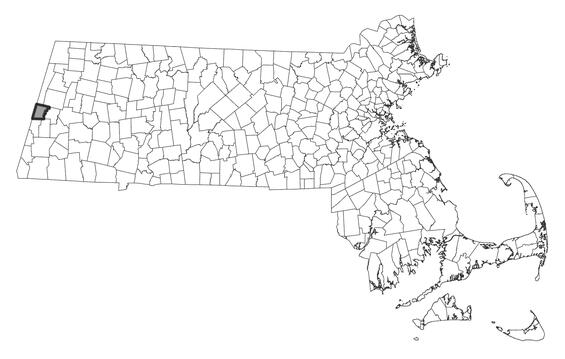- Scientific name: Carex chordorrhiza
- Species of Greatest Conservation Need (MA State Wildlife Action Plan)
- Endangered (MA Endangered Species Act)
Description
Creeping sedge, a member of the sedge family (Cyperaceae), is a perennial, herbaceous, grass-like plant of sphagnum bogs and fens, usually in areas over calcareous bedrock. It is named for its unusual prostrate, creeping growth pattern, where decumbent stems from the previous year send up new shoots from the nodes. Often these horizontal, older shoots are overgrown by moss and are just below the surface, appearing to be rhizomes (underground stems).
To identify the creeping sedge and other members of the genus Carex, a technical manual should be consulted. Species in this genus have tiny, wind-pollinated flowers that are borne in spikes. Each flower is unisexual and is closely subtended by small scales that largely conceal the flowers. The staminate (i.e., pollen-bearing) flowers are subtended by a single scale. The pistillate (i.e., ovule-bearing) flowers are subtended by two scales, an outer flat scale (pistillate scale) and an inner, sac-like scale, called a “perigynium,” that encloses the flower, and later, the achene (a small, hard seed-like fruit). If the perigynium tapers or contracts to a tip, it is described as a “beak.” Creeping sedge is so unique that it is the only member of a sub-group of Carex called section Chordorrhizae. The leaves of this sedge are quite narrow (1-2 mm wide; 0.04-0.08 in) and are shorter than the flowering stems. Leaves of the vegetative stems are longer than those of flowering stems. The spikes are few-flowered, with inconspicuous staminate flowers at the tip of each, and densely clustered, appearing like a single ovoid spike at the tip of the flowering shoot. The perigynia are plump, brown, and many-veined. Perigynia have a short beak that is one-fourth the length of the body. The achenes are lens-shaped.
This sedge is so unique that it is not likely to be confused with other members of the genus Carex. It could, however, be overlooked because of its delicate, slender appearance among dense vegetation and its superficial resemblance to spike-rushes of the genus Eleocharis. However, spike-rushes do not have leaf blades, unlike the very apparent leaves of the creeping sedge.
Population status
Creeping sedge is listed under the Massachusetts Endangered Species Act as Endangered. All listed species are protected from killing, collecting, possessing, or sale and from activities that would destroy habitat and thus directly or indirectly cause mortality or disrupt critical behaviors. The MassWildlife’s Natural Heritage & Endangered Species Program database has 1 record from Berkshire County. This record was observed in 2017.
Distribution and abundance
The documented range of creeping sedge extends from northwestern Canada, Oregon and Montana, to the maritime provinces of Canada, southward through northern New England to New York, Pennsylvania, Indiana, and Iowa. Massachusetts is near the southeastern extent of creeping sedge’s range. Creeping sedge is also found in northern Eurasia.

Distribution in Massachusetts
1999-2024
Based on records in the Natural Heritage Database
Habitat
The single known population of creeping sedge in Massachusetts occurs in a wet, calcareous basin fen in Berkshire County. The soils are peaty muck and small streams are present near the population. Typical calcareous fen species in Massachusetts that may be found growing with creeping sedge include slender woolly-fruited sedge (Carex lasiocarpa), prairie sedge (Carex prairea), shrubby cinquefoil (Dasiphora floribunda, formerly Pentaphylloides floribunda), sweet gale (Myrica gale), bog-willow (Salix pedicellaris), and white beak-rush (Rhynchospora alba).
Healthy habitats are vital for supporting native wildlife and plants. Explore habitats and learn about conservation and restoration in Massachusetts.
Threats
Alterations to the natural hydrology of its habitat are threats to the persistence of creeping sedge.
Conservation
With only one known population of creeping sedge in the Commonwealth, it is difficult to make management recommendations for the species. However, the survival of creeping sedge is linked to the integrity of its natural wetland community. Therefore, any human activities that disturb the vegetation, substrate, or water supply of peatlands in which creeping sedge occurs should be avoided. Introduction of invasive species to the wetland should be avoided and any present should be controlled.
Contact
| Date published: | April 9, 2025 |
|---|